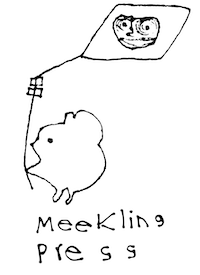Last September C. Relkbi gave a lecture based on her B-Movie creature analysis, featured in The Meekling Review. Her lecture touched on various forms of creatures and popular misconceptions, and included slides of their potential habitats including the one featured in the photo above (taken in a high school bathroom in Gary, Indiana) . In this interview we speak at greater length about Relkbi’s research, the genesis of her interest in these creatures, how they are often inaccurately referred to as “monsters”, as well a her favorite B-Movie creature of all time.
What first drew you to critical creature discourse and the genotypical and phenomenological study of B-Movie creatures?
I suppose what draws anyone to a field of study they are passionate about: childhood exposure. As a kid I watched a lot of B-Movies with my father, who is very talented at pattern recognition. I remember we had many discussions on the similarities and differences between the “monsters”: how they behaved when angered, frightened, surprised, or walking slowly through a marsh or forest. The humans were easy to understand, so I was always more curious about the creatures. I’d never seen one outside of films, so I started doing as much research as I could. Much of it tangential, as the field was and is small, but like my dad I’m pretty good at pattern recognition. My mom studied genetics for a little while, too, so I grew up knowing that in humans adenine pairs with thymine and guanine with cytosine. I wondered: what would B-movie creature DNA base pairs be? Of course we can’t know, but that’s part of the fun, isn’t it? Solving the mystery with the clues at hand.
I think the moment I knew studying B-Movie creatures was what I wanted to spend my career pursuing was when I first saw a B-movie that featured a desert habitat. I grew up in Southern California, and seeing one of those creatures roam my landscape was thrilling. I can’t recall the film, and I’ve searched for it my entire professional life.
For those readers unfamiliar with your branch of research, please describe what you do and the most important conversations happening in critical creature discourse at the moment.
As a B-movie scientist, I study B-movie creatures, or in colloquial (yet inaccurate) terms, “monsters”, in a way analogous to an astronomer studying stars. Both astronomers and myself have to contend with physical and temporal distance, and data that almost entirely comes from EM radiation (though astronomers have available to them the entire EM spectrum, and I must rely on optical and occasionally radio). Much of what I and astronomers do is modeling based on data, as things like control samples are mathematical ideals and our testing laboratories more computational.
I study these creatures to learn more about them, where they live, their peculiarities; what any biologist would say. Compared to the thousands of species of insects or birds or mammals, they are rare, and dependent on celluloid preservation methods. It is important to gather and accurately interpret data before their documentation—thus, in a way, their lives—is unsalvageable.
Some very exciting conversations in critical creature discourse have begun to separate analysis of the creature from anthropocentric psychology. In the past, creature motivation and even existence was all recorded under the shadow of human motivations. But my research and that of my colleagues has shown that, while the human drive must be accounted for in how the creatures are represented, a trove of unexplored data are presented when the creatures are studied as independentof the human psyche. Our hope is that after this more rational examination, the creature and human may be united again for a more complete understanding of each.
What are the most typical misconceptions of B-Movie creatures held by the general public?
The most common misconception I’ve encountered is that all B-movie creatures are violent or aggressive without reason. I believe this to be caused by selection bias and documentary techniques. The cases in which a creature has violently interacted with a human are much more likely to be documented than a peaceful encounter. And, it is much easier to document creatures that reside in habitats that overlap with those of humans. Close quarters will often lead to an interaction of some kind, though in my extensive research I’ve found it is more often the human that escalates the encounter.
Another misconception I run across is that the majority of B-movie creatures were created through nuclear waste. While it’s true that radioactive waste triggered mutations in some, it is mostly a convenient (though important) metaphor for humans and not scientifically accurate. Part of my job is to review documentation and data to parse when human intervention has occurred and when coincidence makes it appear that way.
What are your favorite B-Movie creature(s) and if you yourself could be a B-Movie creature, what would you be?
It’s hard to choose a favorite, but a recent creature I’ve studied and grown fond of is the “mollusk” in The Monster that Challenged the World. It presents a taxonomical difficulty I still haven’t entirely worked out. And, what can I say, I have a soft spot for California creatures.
To be honest, I don’t think I would want to be any of them. I’ve seen how their story ends too many times.
C. Relkbi is a scientist studying the genotypical and phenomenological characteristics of B-movie creatures. Her research focuses on human-creature interactions. She has published numerous papers in a variety of journals.
Rebecca Nakaba is a writer and multi-media artist studying the genotypical and phenomenological characteristics of humans and nature. Her research focuses on human-creature interactions. She has published in places.
FIND MORE B-MOVIE ABSTRACTS in The Meekling Review:

+ COPIES ARE NOW AVAILABLE AT POWELL’s BOOKS in PORTLAND, OR, for all you left coast folks +



